2015 Annual Report for ONC15-010
Farmer-Led Research for Increased Cover Crop and No-Till Adoption in Northwest Wisconsin
Summary
Three on-farm research plots were established in Spring 2015 for local testing of cover crop varieties and seeding methods, as well as side-by-side tillage comparisons with the goal of increasing farmer confidence with cover crops and no-till, and increasing on-farm adoption of these management practices. At each location the farmers planted three replications of the following five treatments:
- No-Till Corn, Cereal Rye Cover Crop
- Conventional-Till Corn, No Cover Crop
- No-Till Corn, No Cover Crop
- Conventional-Till Corn, Cereal Rye Cover Crop
- No-Till Corn, Multi-Species Cover Crop
All locations had previously been conventionally tilled, so 2015 was year one for no-till. We collected data on both biological and agronomic indicators in all three plots. Because this was the first year of data collection and the first year of no-till, we saw little significant difference among plots, however, we did note significant differences in each location in both soil moisture (significantly higher in the no-till plots) and residue cover (higher in the no-till plots). In Spring 2016 the plots will be planted again with the same treatments for tillage and cover but with soybeans.
Objectives/Performance Targets
-
- Establish Test Plots – Plots were established at three locations. We had hoped for four locations, but one of the four participating farmers ran out of time during planting season. We are hoping to recruit a new farmer for Spring 2016 in the fourth location.
- Farmers will see soil health, water quality, and farm performance benefits – With only one year of data it was difficult to demonstrate benefits from cover crops and reduced tillage. However, the project has engaged participating farmers and surrounding farmers in a positive way, as evidenced by field day attendance and interest in outcomes/data.
- Develop a model for farmer-led field trials that can be adopted in other regions – We have engaged multiple stakeholders in this project, including our farmer-led watershed councils (http://blogs.ces.uwex.edu/wflcp/), multiple University of Wisconsin Extension agents and specialists, county conservation departments, and, through participation in our field days, dozens of farmers and crop consultants. We have gotten many questions about project design and funding from others who would like to try similar work, and in this way, we feel that we have already begun meeting this target.
Accomplishments/Milestones
- Pierce County Location:
Brad Peterson, our farmer-partner in Pierce County, established an 18-acre test plot in May 2015 (South Kinni Plot Layout – Image 1). In September 2015, the plot was seeded with cover crops using a modified high-boy seeder. We held three field days at the test plot: at crop planting, at cover crop seeding, and after harvest to view germination. Significant differences were seen in residue cover between no-till and conventional-till plots, as well as in soil moisture between no-till and conventional-till plots. No significant differences were seen in other measures including yield, bulk density, and plant populations. See graphs.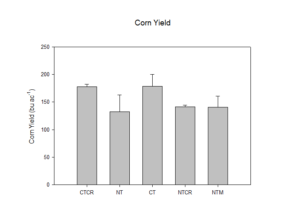
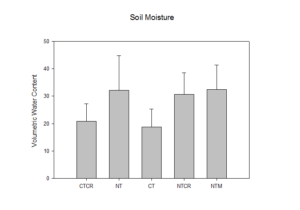
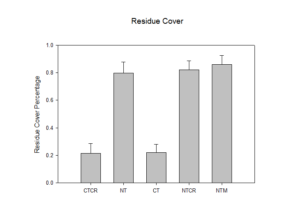
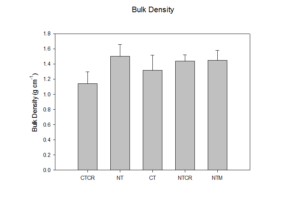 .
.
- Polk County Location:
Scott Carlson (operator) and Timm Johnson (land owner), our farmer partners in Polk County, established a 3-acre test plot in May 2015 (Horse Creek Plot Layout –Image 2). In September 2015, the plot was seeded with cover crops using a hand seeder. We held two field days at the test plot – during the growing season, to explain the test plot design and purpose, as well as to hold a soil health demonstration, and after harvest and cover crop seeding. Significant differences were seen in residue cover between no-till and conventional-till plots, as well as in soil moisture between no-till and conventional-till plots. No significant differences were seen in other measures including yield, bulk density, and plant populations.
- Dunn County Location:
Ben MrDutt, our farmer partner in Dunn County, established a 20-acre test-plot in May 2015 (Horse Creek Plot Layout – Image 3). In September 2015, the plot was seeded with cover crops using a high-boy style box spreader. We held two field days at the location – one after planting crops to explain the plot design and purpose, and one when the cover crops were seeded. At this time, we have not yet received combine data from our farmer partner. Significant differences were seen in residue cover between no-till and conventional-till plots, as well as in soil moisture between no-till and conventional-till plots.
Impacts and Contributions/Outcomes
With our project only being one year old, we cannot yet speak to the outcomes of the work related to increase cover crop and no-till adoption. However, we have had positive impacts and contributions via our field days (engaging farmers and providing content and education they want), newsletter articles (newletter – this was done in place of the originally proposed blogs, as farmers indicated they would be more likely to read a newsletter than go to a blog), and conversations (see photos). We hope that data collected in following years tells a story that supports farmer transitions to these practices.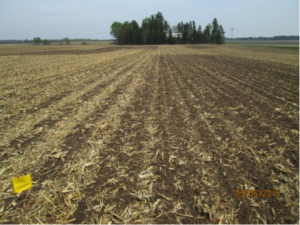
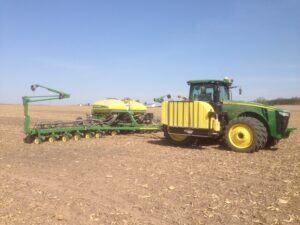
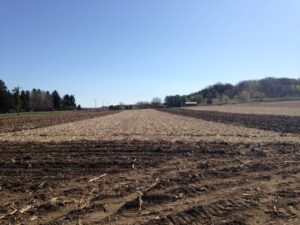
We did encounter some challenges along the way:
- One of our original partner farmers became too busy with his farm management demands and dropped out of the project. We were unable to find a replacement in time for the 2015 planting season.
- It was not easy to find equipment for planting into standing corn. The plots were not situated for aerial seeding, and highboy availability in this area is still minimal. We did find custom operators to do this work, but one lost his highboy to a fire following seeding and so we will again need to look for other custom operators to seed cover.
- We are waiting to see spring establishment of our cover crops but late fall moisture was higher than average which resulted in large slug populations and although cover crops germinated, we saw lots of seedling predation from slugs.
Collaborators:
Conservation Technician
Pierce County Land Conservation Department
412 W Kinne St
Ellsworth, WI 54011
Office Phone: 7152736763
Pierce County Agriculture Agent
University of Wisconsin Extension
412 W Kinne St
Ellsworth, WI 54011
Office Phone: 7152733531
Executive Director
Wisconsin Farmers Union
117 W Spring St
Chippewa Falls, WI 54729
Office Phone: 7157235561
Conservation Planner
Dunn County Land Conservation Department
390 Red Cedar St
Menomonie, WI 54751
Office Phone: 7152316545
Conservation Planner
Polk County Land and Water Resources Department
Suite 120, 100 North 150th Street
Balsam Lake, WI 54810
Office Phone: 7154858699